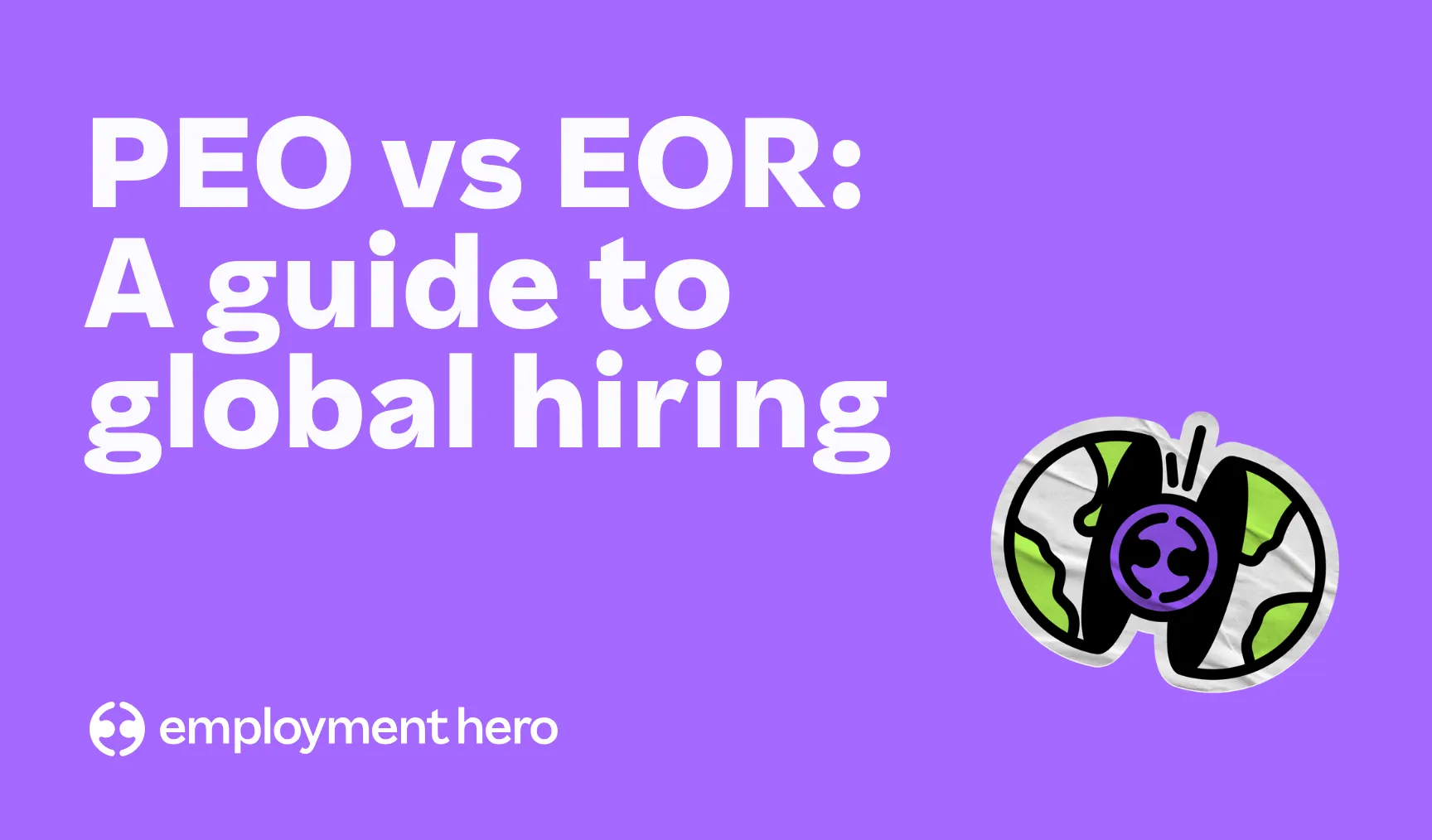Employee “ghosting”: Abandonment of employment explained
In the unfortunate event that this happens to your business, we’ve got the advice you need and some guidance on the next steps.

Contents
We’re all familiar with the concept of “ghosting” – maybe you’ve left that awkward date last Friday on “read”, and plan to forever. Or you’ve reached out to an old contact and heard radio silence, despite repeated attempts. Ghosting these days, particularly in the digital age, isn’t uncommon.
However, what happens if that person doing the unexpected disappearing act is your employee? It doesn’t happen often, but occasionally it does. There may be reasons for their absence, but if it turns out that they’ve left for good, that’s called “abandonment of employment”.
In the unfortunate event that this happens to your business, we’ve got the advice you need and some guidance on the next steps.
What classifies as “abandonment of employment”?
If an employee has not turned up to work for a few days without notifying their employer, that doesn’t always mean that they have officially abandoned work. They may be dealing with an unexpected issue that makes it difficult to get in contact, or may have informed the wrong person that they’ll be away from the office.
The main thing that classifies “abandonment of employment” is intention – if they’ve left with no intention of coming back to work and haven’t reached out or given notice of their plans, that’s abandonment. They could have left work in the middle of a working day, or just not turned up at all.
There isn’t a legal number of days with an employee away from work that counts as abandonment, but the Employment NZ website advises three days or more. It’s unwise to start the process too quickly, as there may be a valid reason for their absence that you don’t yet know.
 How to respond as an employer
How to respond as an employer
Firstly, it’s your duty of care as an employer to check on the employee’s status and their intentions. You must be able to show that you have made a significant effort to get in contact on the first day of absence, and then on multiple occasions after that. That includes calling all contact numbers several times, as well as leaving messages and sending emails. Even visiting their home counts, depending on your relationship with the employee. Of course, do this with caution and respectfully.
Remember that there are genuine circumstances where an employee cannot let you know that they’re unable to come to work – for example, in the case of a serious medical event. If possible, someone close to them should let you know on their behalf or you should try and reach out to their contacts. This is where having emergency contacts for employees is useful as well, as that’s another number to call.
If the employee left your workplace in a dramatic way, they may have been caught up in the heat of the moment. Reaching out after they have left allows you to understand what they intend to do, and give them the opportunity to cool off before returning to work.
If contact is successful, take the relevant steps depending on the information you have received from the employee and the employment agreement.
For example, if they want to resign, you’ll have to discuss and implement the applicable notice period. Discuss sick leave taken or disciplinary measures if applicable, or set a date to check in later if the issue keeping them away is serious and immediate. If they want to return, be sure to address any issues in your workplace that led to their absence e.g. bullying.
If contact is unsuccessful, and there has been no communication between employer and employee, then you can take steps to dismiss the employee for abandonment.
Dismissing an employee for abandonment
To dismiss an employee for abandonment, following a protracted attempt to get in contact with no success, you should follow these steps:
Step one
Formally let the employee know by phone or email, and in writing to their address, that their employment is now at risk. Give them a date and time to get back in contact with you and notify them that no contact will result in their employment being considered as ended due to abandonment.
Example notification letter
Dear [insert employee name], I am contacting you by letter as I have been unable to make contact with you directly despite multiple attempts to phone you on [insert the dates you tried] and email you on [insert the date(s) you emailed], since you did not attend work on [insert date]. As I was concerned for your wellbeing when I was not able to get hold of you, I also contacted your emergency contact, however they were not able to provide me with any reason as to why you had not been into work. On [insert date] I also stopped around to your house but I could not get anyone to come to the door. I am requesting that you, or a representative of yours, urgently make contact with me by phone or email. The thing I need to discuss with you relates to the following: On [insert date], you did not come into work as contracted. You did not call or indicate in any way why you were not able to work and I was unable to get hold of you. As outlined above, I have been trying since then to make contact with you. As you are aware, if you are sick, or need to be absent for the day, the company policy is for you to contact [insert manager name] as soon as possible to let us know. However I have had no contact from you since you did not come to work. I have been left to presume that you may have abandoned your employment. You, or a representative of yours, are invited to contact me by [insert date and time] if there are any circumstances that we should be made aware of relating to your absence. If I do not hear from you, I will need to assume that this is confirmation that you have abandoned your employment and do not intend to return to your employment at [insert company name]. Yours sincerely, [insert employer name & business]
Step two
If you have no response to this by the set time, advise them by phone or email, and in writing, that their employment is now considered terminated by reason of abandonment.
Example final letter
Dear [insert employee name], As you know I have been trying to contact you to discuss your employment with [insert company name]. I sent you a letter and email on [insert date] which outlined the reasons why I needed to speak or meet with you and requested that you urgently contact me. The things I needed to discuss with you relate to the following incident: On [insert date], you did not come into work as contracted. You did not call or indicate in any way why you were not able to work and I was unable to get hold of you. As outlined above, I have been trying since then to make contact with you. However despite my requests for you to make contact with me I have still not heard from you and it has been [insert number of days or weeks] that you have been out of contact. Since my last email and letter I have tried many more times to contact you on your mobile but have not been able to get through to you. As I have still not heard anything further from you despite my many requests, I have concluded that you have terminated your employment at [insert business name] through abandonment of employment. I have prepared your final pay and this will be directly credited to your bank account. I invite you to contact me if there is anything further that you need to discuss with me. Yours sincerely, [insert employer name & business]
As with all employment issues, you should act fairly and reasonably throughout. You should also keep a record of your contact with the employee, should there be a legal dispute later on.
Case example
Mark Allan Robinson, an unqualified builder hired by Armour Group Limited (AGL) in July 2022, was ordered by the Employment Relations Authority (ERA) to pay $3,000 to his former employer for abandoning his job without notice.
Robinson left his job abruptly in January 2023, claiming he faced defaming remarks from other employees. Upon his departure, he used a company car to drive home and returned it outside business hours.
By March, AGL processed his full final pay but filed a case with the ERA for breach of contract due to Robinson’s lack of notice. The ERA sided with AGL, noting Robinson’s failure to address concerns with the employer before leaving and his breach of the employment agreement by not providing a month’s notice. Consequently, Robinson was ordered to compensate AGL for the abrupt abandonment.
Policies around employment abandonment
It’s the same for all problems that can arise in employment – it helps to have a policy in place, just in case. You may want to create a workplace policy that covers what classifies as abandonment of employment, and ensure that all employees have read and understand.
You may also want to add a clause in your individual employment agreements, which specifies the number of unauthorised absence days (e.g. 3 or 5 days) before abandonment of employment is considered. This could include the steps you as an employer will take in this situation. It’s a good way to standardise your business’s approach to this issue and to ensure legal compliance.
Build a strong workplace with Employment Hero
Running a business isn’t easy. Here at Employment Hero, we want to equip you with the key HR and payroll tools that you need to be a fair and supportive employer. Our software can help create a positive workplace culture, where openness and strong communication is encouraged.
Plus, Employment Hero can help you as you ensure business compliance, whether that’s setting workplace policies, assigned employment agreements, calculating payroll or ensuring accurate documentation of health and safety issues. We’ve got an entire policy template library that you can borrow from, customise and implement amongst your team. It’s employment, solved.
To find out more, book a call with one of our business specialists today.
Disclaimer: The information in this article is relevant as at 6 June 2024, and has been prepared by Employment Hero Pty Ltd ABN (11 160 047 709) (Employment Hero). The views expressed herein are general information only and are provided in good faith to assist employers and their employees. The Information is based on data supplied by third parties. While such data is believed to be accurate, it has not been independently verified and no warranties are given that it is complete, accurate, up to date or fit for the purpose for which it is required. Employment Hero does not accept responsibility for any inaccuracy in such data and is not liable for any loss or damages arising either directly or indirectly as a result of reliance on, use of or inability to use any information provided in this article.
Related Resources
-
 Read more: Top 6 skills for recruiters in New Zealand (2026)
Read more: Top 6 skills for recruiters in New Zealand (2026)Top 6 skills for recruiters in New Zealand (2026)
Discover the essential skills for recruiters in NZ. Learn what makes a great recruiter — from communication to tech expertise.…
-
 Read more: PEO vs. EOR: A guide to global hiring
Read more: PEO vs. EOR: A guide to global hiringPEO vs. EOR: A guide to global hiring
Learn the key differences between a PEO and an EOR. Discover why an EOR is the smarter, safer way to…
-
 Read more: How to build a global team without a local entity
Read more: How to build a global team without a local entityHow to build a global team without a local entity
Learn how to streamline your hiring and expand your NZ business globally with an Employer of Record (EOR) without the…






















